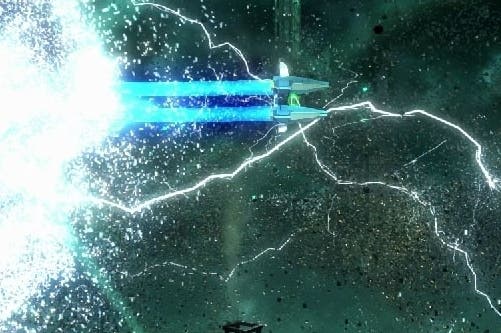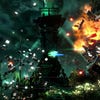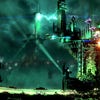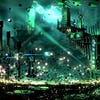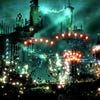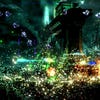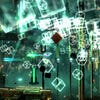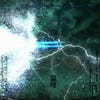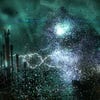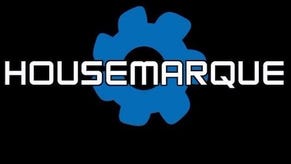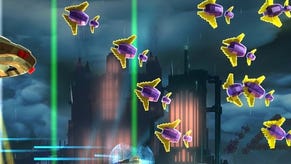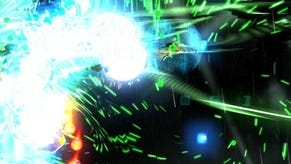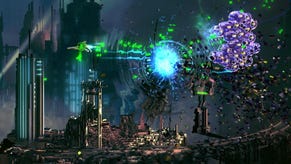Digital Foundry vs. Resogun
Head-to-head with Housemarque, plus exclusive PlayStation 4 60fps gameplay video.
"Resogun definitely would not be possible on this [current] generation of hardware," says Housemarque lead programmer Harry Kruger. "The approach would need to have been a lot different and we'd have to have cut a lot of corners. Quite simply the result wouldn't be the same. When you're developing for multiple platforms, the weakest platform basically becomes the lead platform. Essentially this version would have been a port."
It's day one of Gamescom 2013 and Digital Foundry is attending Sony's indie showcase, playing Housemarque's PS4 debut and talking tech with the developer - and we're hugely impressed with the game. Resogun ticks all the boxes in what we would want from a console exclusive - it's feels great to play, it's technologically groundbreaking, visually arresting and built from the ground up with the capabilities of the host hardware specifically in mind. Remember when Mark Cerny talked about GPU compute becoming more important a few years into the PS4 lifecycle? Resogun - a launch title - is already putting the Radeon graphics hardware through its paces with a range of effects that could only be done on a system built upon a surfeit of GPU power, a console like PlayStation 4.
Resogun works because it combines state-of-the-art tech and next-gen visuals with an extremely simple concept - the exact same core-gamer-pleasing formula that made Super Stardust HD one of the best shooting games of the current generation. It's a game that not only validates your next-gen console purchase with all the technological whizz-bangs you could ask for, but delivers the same style of gameplay that made you fall in love video games in the first place.
"Resogun is to Defender what Stardust is to Asteroids, so we try to keep the same qualities as Stardust: hectic gameplay, lots of explosions, simple controls," says Harry Kruger. "But we wanted to try something different, so we added this layer of gameplay where you collect humans, take them to the escape pods and then you get rewarded with power-ups in the process."
Gameplay clearly hails from the old-school "score attack" arcade tradition - a genre that has unfortunately fallen by the wayside during the current-gen era, represented by just a handful of games like Super Stardust and Geometry Wars. These are games that are conceptually at odds with the modern day triple-A experience - spectacular scripted set-pieces, infinite lives and hand-holding gameplay simply aren't part of the equation. The rollercoaster-style thrill of the modern day score attack game is defined very much by the player's skill - the better you become, the more exciting, tense and dangerous the experience feels - and as a bonus, the more insane the on-screen effects. Spectacle isn't handed to you on a plate - you earn it. You create it. We saw that in Super Stardust, but Resogun takes that to the next level.
Alternative 720p60 version: Capable hardware required for smooth playback.
Enormous explosions, waves of enemies and bullet storms are all par for the course, backed by the screen-filling pyrotechnics you've come to expect from this developer. Housemarque's approach in realising the digital carnage is intriguing: environments are created from hundreds of thousands of cubes, each of which is individually animated by GPU-accelerated physics.
"The entire environment - everything - is built up from these voxels," explains Kruger. "All of the cubes that you see flying around - there's no gimmick, no point sprites, it's not a particle effect, they're actual physical cubes. In gameplay, dynamic cubes with collisions, floating around, you can get up to 200,000. Our engine supports up to 500,000 but in actual gameplay scenarios, it rarely goes over 200K."
The technology behind the cube-based construction of each level is as typically ingenious as you would expect from a Housemarque title.
"It's actually pretty interesting tech because as you can see, the environments are fully destructible and both the background and the gameplay ring are loaded from 3D textures - and then they're polygonised on the fly," Kruger says.
"So basically what happens is that the mesh for the actual background geometry is generated, then when an explosion happens and a part of it is chipped away, that particular segment is reconstructed. That's what's happening on the GPU side with compute shaders - but with nice performance."
Resogun's aesthetic is almost entirely defined by its remarkable physics, and it's a match made in heaven with the compute-heavy skew of the PlayStation 4 hardware. Harry Kruger reels off a list of the various non-render based effects that utilise the PS4 graphics hardware.
"We're using compute shaders for a lot of things like the Overdrive particles you see later, the lightning up there - that's all done on GPU. The actual cubes - the physics and the collisions that you see bouncing, the geometry - that's all done on the GPU-side," he says, before going into more depth on how the 3D texturing works on the 'ring' - the gameplay layer of the environment.
"For the ring, it's the same thing as the background but slightly different tech because here we have one 3D texture that's basically one long rectangular prism. We use these bent cubes, or curved cubes - that's a better way of putting it. Every time an explosion happens these are essentially detached from the world."
"All of the cubes that you see flying around - there's no gimmick, no point sprites, it's not a particle effect, they're actual physical cubes."
All of which sounds as though creation of Resogun's environments would require a somewhat original approach to level creation. The flexibility of Housemarque's approach means that - in theory - levels could be created on the fly using procedural generation. However, the team wanted to keep their artists in control of the process, so traditional tools were utilised to craft the original, distinctive look of the game.
"We're kind of using an unusual process. We're using Maya to define the levels, but we use our own tools to generate the 3D textures," Kruger reveals, explaining the benefits for the developers. "The artists do get to see this on their screen in Maya, they get to work with the lighting, add all the effects and so on and then it's actually processed as a 3D texture and polygonised."
Resogun is distinctive because everything about it is designed to service this particular gameplay experience for just this one piece of console technology. In a world where game technology is designed to be scalable across various pieces of hardware with very different performance levels, the result feels fresh and exciting yet, at the same time, evocative of the PS2 era, when the majority of games were built around the specific strengths of Ken Kutaragi's forward-looking hardware. In the present day, it's the PS4's graphics tech and the sheer volume of memory available that are singled out by Housemarque:
"Compute shaders are the big thing and of course the RAM," says Harry Kruger. "We're using over 500 megabytes just for the level geometry. It's all optimised in real-time. We don't have the full 3D texture in memory because as you can see, the level's pretty empty in this case so all the levels are generated into separate sub-meshes."
After a fairly hopeless first effort on our part, Kreuger takes the controls. The screen comes alive with total destruction as he cuts effortlessly through the waves of oncoming enemies, scooping up humans, dropping them off at the rescue point and powering up his weaponry. Heading for terra firma and Overdriving his way through the gun turrets, the screen explodes with hundreds of animated cubes. As our discussion continues, a native 1080p60 is confirmed, with a deferred lighting system in place for theoretically illuminating the scene with hundreds of light sources, but Housemarque is surprisingly restrained in its usage.
"Practically, it would just be too noisy visually," he explains.
On top of the full HD, 60Hz experience, it's clear that Resogun's presentation is extremely clean. A deferred lighting solution would suggest that - in common with most next-gen console games - multi-sampling anti-aliasing (MSAA) is off the table, yet aside from just a tiny touch of pixel flicker around the main ship, Resogun looks really smooth.
"The boss is an early version and isn't representative of final code. There's going to be a lot more feedback, more explosions, a lot more particles."
"It's our own anti-aliasing technique - it's post-process. Pretty much everything we have is our own, developed from the ground up," Kruger says proudly, before putting his own role on the project into context.
"Technically I'm lead programmer on this project, but I'm mostly concentrating on the gameplay side of things. We actually have a talented group of tech and R&D guys and they're the ones who come up with this tech."
And with a final hail of bullets, the alien hordes of this first level are despatched, with the mass arrival of hundreds of glowing wireframe cuboids signaling the approach of the inevitable end-of-level boss, a multi-ringed, bullet-spitting, spinning monstrosity.
"Those were the actual physical cubes that were assembling the boss. We have this destruction that is applied to pretty much everything and it's only going to get even more detailed," Kruger points out. "The boss is an early version and isn't representative of final code. There's going to be a lot more feedback, more explosions, a lot more particles."
Impressive stuff. Resogun has only been in development for 18 months, and the quality of this code - which almost maintains its 1080p60 target - is exceptionally good. For a game that emphasis GPU compute so much, for Housemarque to have come so far so quickly is testament to the skills of its development team. Development of this PS4-specific game must surely have begun on unfinished hardware, and Kruger acknowledges that this is the case. When I suggest that coding for PS4 so specifically on prototype hardware must have been exceptionally challenging, the response is a simple "indeed".
The game you see on this page is described as "work in progress, but relatively indicative of what we're going for" - and we're told that the main push for optimisation has yet to begin. The small dips in the frame-rate will almost certainly be ironed out, and as the demo level concludes with the destruction of the boss and the complete obliteration of the entire level into its individual, GPU-driven component cuboids, we get perhaps the most dramatic example yet of the host hardware's computational power.
It's beautiful stuff, and Sony itself clearly agrees. Resogun is not only a spearhead title for PS4's indie push, the platform holder is dangling the game enticingly before us as a value-added bonus for PlayStation Plus subscribers; members get the game at no additional cost for as long as their sub remains topped up, in common with every other title in the "instant game collection".
We've only spent scant minutes playing the game and clearly there's a long way to go yet before Housemarque is happy to sign off on final code - but everything we've seen thus far, in combination with the pedigree of the developer, points to a day one shooter of excellent quality. With many of us getting the game for free on day one, the PlayStation 4 value proposition just got even stronger.
